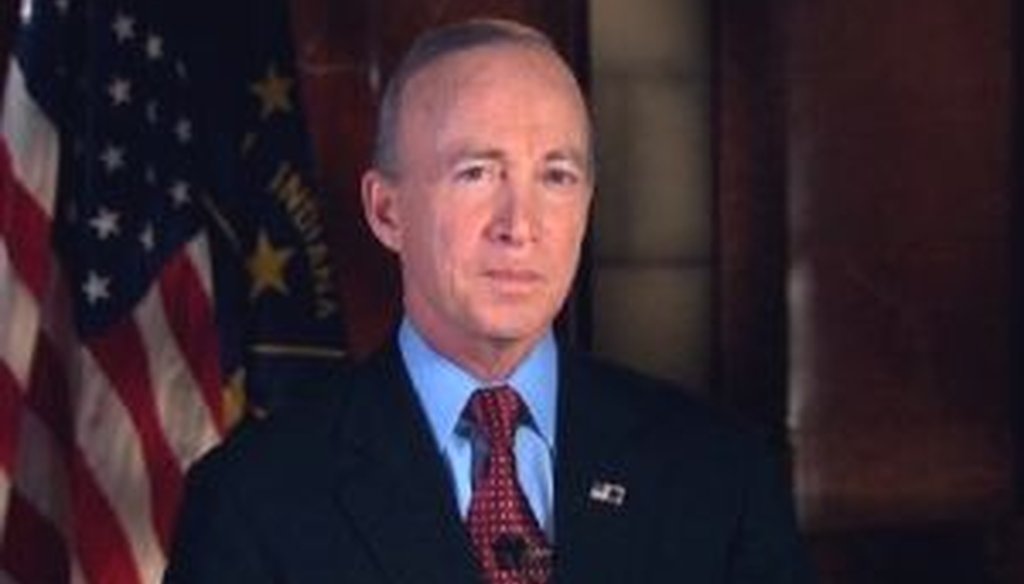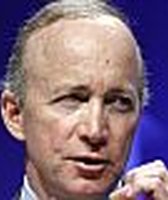Stand up for the facts!
Our only agenda is to publish the truth so you can be an informed participant in democracy.
We need your help.
I would like to contribute

Indiana Gov. Mitch Daniels gave the Republican response to President Barack Obama's 2012 State of the Union address.
Mitch Daniels says 'nearly half of all persons under 30 did not go to work today'
During the Republican response to the State of the Union address, Indiana Gov. Mitch Daniels painted a grim picture of American employment today.
"The president did not cause the economic and fiscal crises that continue in America tonight, but he was elected on a promise to fix them, and he cannot claim that the last three years have made things anything but worse," Daniels said in the nationally televised address. "The percentage of Americans with a job is at the lowest in decades. One in five men of prime working age and nearly half of all persons under 30 did not go to work today."
There are a lot of facts in that sentence, but many readers zeroed in on the claim that "nearly half of all persons under 30 did not go to work today." So we’ll take a look at it.
We turned to numbers from the Bureau of Labor Statistics, the federal agency responsible for tabulating employment statistics. The bureau’s website allows users to mix and match the national data by various sub-categories, including age.
There’s no single category for "under 30," and BLS doesn’t calculate data on those below the age of 16, but we were able to put together an "under 30" category by merging four others: 16 to 17; 18 to 19; 20 to 24; and 25 to 29. This also allowed us to compare statistics for those separate groups.
The purest comparison we did -- one that seems to track Daniels’ statement most closely -- is to divide the number of people employed by the total number of persons in that age group. This statistic is known as the "employment to population ratio." We then flipped this ratio around to mirror how Daniels phrased it -- the total of persons not working divided by total population in that age group.
For December 2011, the most recent month available, we found that 44.4 percent of the 16-to-29 age group was not employed. So, Daniels is in the ballpark.
But there’s a problem: This is a ridiculous statistic to use. It includes Americans aged 16 to 18 (who are supposed to be in high school) and those 18 to 22 (many of whom are in college). If you leave high schoolers out of the equation and look only at ages 18 to 29, then the percentage who are not working declines to 37.5 percent. If you look only at ages 25 to 29, an age when most people are out of school altogether, it declines further, to 27.1 percent.
But even this is beside the point if you are trying to craft a credible statistic.
Featured Fact-check
A more appropriate measure for Daniels would have been the tried-and-true unemployment rate.
The unemployment rate takes the number of unemployed people and divides it by those who are "in the labor force," which means that they are either employed or are jobless but looking for work. This measurement ignores people who are not seeking work, such as students or individuals who are raising children full-time or are unable to work for whatever reason.
These statistics offer a significantly different picture. In the broadest age range -- 16 to 29 -- the unemployment rate is 13.6 percent. For those between 18 and 29, it’s 12.9 percent. For those between 20 and 29, it’s 11.9 percent. And for those between 25 and 29, it’s 9.7 percent.
None of these measures gets Daniels any higher than 13.6 percent of the population -- far lower than the nearly 50 percent figure he cited.
Our ruling
We suppose in a narrow sense, Daniels has a point that "nearly half of all persons under 30 did not go to work today." But that’s because the number includes many people who have no desire to work -- for instance, full-time high school or college students, stay-at-home parents or others who are unable to work.
We can understand the concern about the nation’s current high level of unemployment, particularly among youth. Americans age 16 to 19 have an unemployment rate of 23.1 percent, and those who are 20 to 24 have a rate of 14.4 percent -- both well above the 8.5 percent for all age groups, which is itself elevated from historical averages.
Still, the statistic Daniels chose to document this one is a wildly misleading one. We rate it Pants on Fire.
UPDATE: After we published our story, a spokeswoman for Gov. Daniels replied to our query. She said that "the employment-to-population ratio, which captures the number of people working as a percent of the population, is an important indicator of economic activity and the health of the society. For the 16-to-29-year-old cohort, the ratio peaked at 68.2 percent in 1989 and declined by 7.5 percentage points over the next 19 years, reaching 60.7 percent in 2008. The EPOP was 55.2 percent for 2011. So the nearly half -- 44.8% -- is correct. I would not agree that only those captured as unemployed in the unemployment rate are of concern. The total number of people actually working is important. Of course the governor wants students to pursue post-secondary education and has pursued ways to make it easier for them to do so during his tenure as governor."
We stand by our original ruling.
Our Sources
CNN, "Transcript: Daniels gives GOP response to State of the Union," Jan. 24, 2012
Bureau of Labor Statistics, "Labor Force Statistics including the National Unemployment Rate (Current Population Survey - CPS)," accessed Jan. 25, 2012
Bureau of Labor Statistics, "How the Government Measures Unemployment," accessed Jan. 25, 2012
E-mail interview with Jane Jankowski, spokeswoman for Gov. Mitch Daniels, Jan. 25, 2012
Browse the Truth-O-Meter
More by Louis Jacobson
Mitch Daniels says 'nearly half of all persons under 30 did not go to work today'
Support independent fact-checking.
Become a member!
In a world of wild talk and fake news, help us stand up for the facts.












































